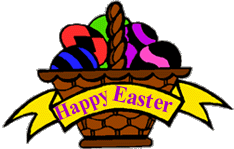

The History,
Traditions and Symbols of Easter
(Please allow the entire
page to load before scrolling and don't forget to turn on your speakers.)
The Symbols of Easter
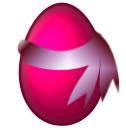

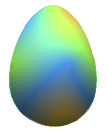

Easter Eggs
According to the book "Festivals and
Celebrations," eggs were dyed in ancient times by the Egyptians and
Persians, who then exchanged them with friends. "It was in Mesopotamia that
Christians first gave eggs to their friends at Easter to remind them of the
resurrection of Jesus," author Rowland Purton writes.
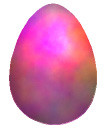 If Lent is observed as it was intended to be, eggs are a
forbidden food (this is why eggs were used on Shrove Tuesday). Centuries ago,
when Lent ended on Easter Sunday, it became tradition for people to give
decorated eggs as presents to their friends and servants. Over time, the
tradition of painting or decorating eggs has continued, particularly with the Ukrainians
and other eastern Europeans known for their beautiful and intricate designs.
If Lent is observed as it was intended to be, eggs are a
forbidden food (this is why eggs were used on Shrove Tuesday). Centuries ago,
when Lent ended on Easter Sunday, it became tradition for people to give
decorated eggs as presents to their friends and servants. Over time, the
tradition of painting or decorating eggs has continued, particularly with the Ukrainians
and other eastern Europeans known for their beautiful and intricate designs.
The bejeweled "Easter Egg" created by the artist Peter Carl Faberge in the late 1880s in St. Petersburg, Russia, is the extreme of egg decorating. The lapis lazuli egg is a gold, enamel, pearl, diamond and ruby creation that features a hinged, enameled "yolk" that conceals a royal crown. This crown is also hinged and opens to reveal a ruby egg. Though this Easter egg is not documented among the Russian Imperial Eggs, experts say it was probably created for a member of Russian royalty.
 Of all the symbols associated with Easter the
egg, the symbol of fertility and new life, is the most identifiable. The customs
and traditions of using eggs have been associated with Easter for centuries.
Of all the symbols associated with Easter the
egg, the symbol of fertility and new life, is the most identifiable. The customs
and traditions of using eggs have been associated with Easter for centuries.
Originally Easter eggs were painted with bright colors to represent the sunlight of spring and were used in Easter-egg rolling contests or given as gifts. After they were colored and etched with various designs the eggs were exchanged by lovers and romantic admirers, much the same as valentines. In medieval time eggs were traditionally given at Easter to the servants. In Germany eggs were given to children along with other Easter gifts.
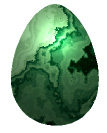 Different cultures have developed their own ways
of decorating Easter eggs. Crimson eggs, to honor the blood of Christ, are
exchanged in Greece. In parts of Germany and Austria green eggs are used on
Maundy Thursday (Holy Thursday). Slavic peoples decorate their eggs in special
patterns of gold and silver.
Different cultures have developed their own ways
of decorating Easter eggs. Crimson eggs, to honor the blood of Christ, are
exchanged in Greece. In parts of Germany and Austria green eggs are used on
Maundy Thursday (Holy Thursday). Slavic peoples decorate their eggs in special
patterns of gold and silver.
Austrian artists design patterns by fastening ferns and tiny plants around the eggs, which are then boiled. The plants are then removed revealing a striking white pattern. The Poles and Ukrainians decorate eggs with simple designs and colors. A number of eggs are made in the distinctive manner called pysanki (to design, to write).
Pysanki eggs are a masterpiece of skill and
workmanship. Melted beeswax is applied to the fresh white egg. It is then dipped
in successive baths of dye. After each dip wax is painted over the area where
the preceding color is to remain. Eventually a complex pattern of lines and
colors emerges into a work of art.
In
Germany and other countries eggs used for cooking where not broken, but the
contents were removed by piercing the end of each egg with a needle and blowing
the contents into a bowl. The hollow eggs were died and hung from shrubs and
trees during the Easter Week. The Armenians would decorate hollow eggs with
pictures of Christ, the Virgin Mary, and other religious designs.

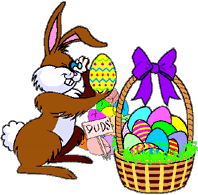
Eggs play an important part in Easter sports. The Romans celebrated the Easter season by running races on an oval track and giving eggs as prizes. Two traditional Easter egg games are the Easter Egg Hunt and the Easter Egg Roll.
On Easter morning the children of the house join in a search to locate the eggs that the Easter Bunny had hidden while they where asleep. The searching might continue though out the house with the older children helping the youngest. Sometimes prizes of candy are awaiting the child finding the most eggs.
Easter egg hunts can are also part of a community's celebration of holiday. The eggs are hidden in public places and the children of the community are invited to find the eggs.
The rules of an Easter Egg Roll are to see who can roll an egg the greatest distance or can make the roll without breaking it, usually down a grassy hillside or slope.
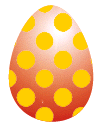 Maybe
the most famous egg rolling takes place on the White House Lawn. Hundreds of
children come with baskets filled with brightly decorated eggs and roll them
down the famous lawn, hoping the President of the United States is watching the
fun.
Maybe
the most famous egg rolling takes place on the White House Lawn. Hundreds of
children come with baskets filled with brightly decorated eggs and roll them
down the famous lawn, hoping the President of the United States is watching the
fun.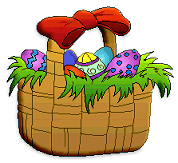
Of all the symbols associated with Easter the egg, the symbol of fertility and new life, is the most identifiable. The customs and traditions of using eggs have been associated with Easter for centuries.
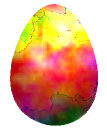
A Polish folktale tells of the Virgin Mary giving eggs to soldiers at the cross
as she pleaded with them to be merciful. As her tears dropped they spattered
droplets on the eggs mottling them with a myriad of colors.
Long before Jesus, people used to give each other eggs as
presents. These eggs were dyed or painted in fancy
colors and designs. Some of
the most elaborate and beautifully designed eggs came from
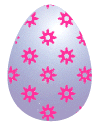 countries such as the
Ukraine. The tool used by the Ukrainians was called a Kistka. It's a
brass cone mounted on a stick. The artist filled this with wax and heats it so
that the wax melts, the artist then draws patterns on the melted wax. All the
designs used have a religious meaning.
countries such as the
Ukraine. The tool used by the Ukrainians was called a Kistka. It's a
brass cone mounted on a stick. The artist filled this with wax and heats it so
that the wax melts, the artist then draws patterns on the melted wax. All the
designs used have a religious meaning.
Every country has its own customs. In the Northern counties of England the children go around begging for eggs and other presents and acting out the Pace egg Play, this was known as "Pace egging".
"Pace eggs" comes from the Hebrew word Pesach (Passover). In Scotland the word also appears as Peace or Paiss.
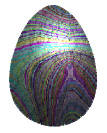 Since ancient times many cultures have associated eggs with the universe.
They've been dyed, decorated, and painted by the Romans, Gaul's, Persians, and
the Chinese. They were used in spring festivals to represent the rebirth of
life. As Christianity took hold the egg began to symbolize the rebirth of man
rather than nature.
Since ancient times many cultures have associated eggs with the universe.
They've been dyed, decorated, and painted by the Romans, Gaul's, Persians, and
the Chinese. They were used in spring festivals to represent the rebirth of
life. As Christianity took hold the egg began to symbolize the rebirth of man
rather than nature.
During the 4th century consuming eggs during Lent became taboo. However, spring
is the peak egg-laying time for hens, so people began to cook eggs in their
shells to preserve them. Eventually people began decorating and hiding them for
children to find during Easter, which gave birth to the Easter Egg Hunt. Other
egg-related games also evolved like egg tossing and egg rolling.
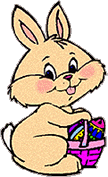

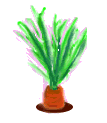
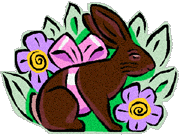
The Easter Bunny
The Easter Bunny, a cute little rabbit that hides eggs for us to find on Easter.
In the rites of spring the rabbit symbolized fertility. In a German book dated 1682,
a tale is told of a bunny laying eggs and hiding them in the garden.
Rabbits are a powerful symbol of fertility and new life, and therefore, of Easter. The Easter Bunny, like Santa Claus, has become a popular children's character. But it may be that the Easter Bunny is something of a historical mistake.
Hares were sacred to the pagan festival of Eostre. At some point, the hare was replaced by the rabbit (some say that this is because it is difficult to tell hares and rabbits, both long-eared mammals, apart).
The Easter bunny has its origin in pre-Christian fertility lore. The Hare and the Rabbit were the most fertile animals known and they served as symbols of the new life during the Spring season.
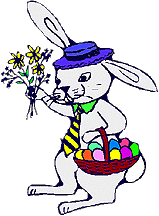 The bunny as an Easter symbol seems to have
its origins
in Germany, where it was first mentioned in German writings in the 1500s. The
first edible Easter bunnies were made in Germany during the early 1800s. These
were made of pastry and sugar.
The bunny as an Easter symbol seems to have
its origins
in Germany, where it was first mentioned in German writings in the 1500s. The
first edible Easter bunnies were made in Germany during the early 1800s. These
were made of pastry and sugar.
The Easter bunny was introduced to American folklore by the German settlers who arrived in the Pennsylvania Dutch country during the 1700s. The arrival of the "Oschter Haws" was considered "childhood's greatest pleasure" next to a visit from Christ-Kindel on Christmas Eve. The children believed that if they were good the "Oschter Haws" would lay a nest of colored eggs.
The children would build their nest in a secluded place in the home, the barn or the garden. Boys would use their caps and girls their bonnets to make the nests . The use of elaborate Easter baskets would come later as the tradition of the Easter bunny spread through out the country.
Easter Bells
Easter Bells are rung in France and Italy throughout the year but they are not rung on the Thursday before Good Friday. They are silent as way to remember the death of Jesus. They are then rung on Easter Sunday as way of telling people Jesus is alive again.
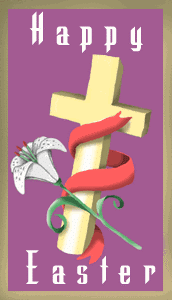 The
Cross
The
Cross
The Cross is the symbol for the Christian religion as Jesus was nailed to a cross but then came back to life.
The Cross is the symbol of the Crucifixion, as opposed to the Resurrection. However, at the Council of Nicaea, in A.D. 325, Constantine decreed that the Cross was the official symbol of Christianity. The Cross is not only a symbol of Easter, but it is more widely used, especially by the Catholic Church, as a year-round symbol of their faith.
The Easter Lily - The lily was a reminder to the Christians of how Jesus came back to life.
Easter Flowers- Such as daffodil, narcissus and the tulip. Area symbol as they bloom in the spring.
Pussy Willows- These are especially picked at Easter in
England and Russia. People would tap each other on the shoulders with a branch
of the pussy willow for good luck.
Lambs - The lamb is a symbol as people thought of Jesus as the Good Shepherd who would watch over them as they were lambs.

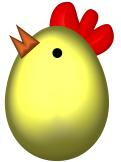 Rabbits
- Rabbits are reminder of spring and new life.
They were the favorite animal of the spring goddess Easter.
Rabbits
- Rabbits are reminder of spring and new life.
They were the favorite animal of the spring goddess Easter.
The Egg - These are a symbol of spring as well as Easter. They are a sign of new life.
Chicks - The chicks are born from eggs and are a reminder of spring and Easter.
Hot Cross Buns
According to the book Dates and Meanings of Religious & Other
Festivals," hot cross buns "... used to be kept specially for Good
Friday with the symbolism of the cross, although it is thought that they
originated in pagan times with the bun representing the moon and its four
quarters."
The custom of eating hot cross buns goes back to
pre-Christian times, when pagans offered their god, Zeus, a cake baked in
the form of a bull, with a cross upon it to represent its horns. Throughout the
centuries, hot cross buns were made and eaten every Good Friday, and it was
thought that they had miraculous curative powers. People hung buns from their
kitchen ceilings to protect their households from evil for the year to come.
Good Friday bread and buns were said never to go moldy. This was probably
because the buns were baked so hard that there was no moisture left in the
mixture for the mold to live on. Hot cross buns and bread baked on Good Friday
were used in powdered form to treat all sorts of illnesses.
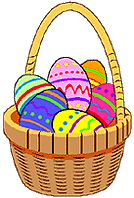

The Easter Basket
The Easter Basket shows roots in a Catholic custom. Baskets filled with breads,
cheeses, hams, and other foods for Easter dinner were taken to mass Easter
morning to be blessed. This evolved into baskets filled with chocolate eggs,
jellybeans, toys, and stuffed bunnies for children left behind by the Easter
Bunny.
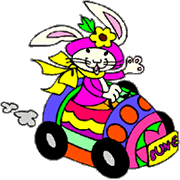
The Easter Bonnet
The Easter bonnet and new clothes on Easter symbolizes the end of the dreary
winter and the beginning of the fresh, new spring. At the turn of the century,
it was popular for families to stroll to church and home again to show off their
"Sunday best".
![]()
Worldwide Easter Celebrations
Here are a few ways in which Easter is celebrated by Christians around the
world:
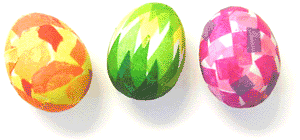 eggs over each
other's heads in the week before Lent begins! Fortunately, these eggs are
filled with small pieces of paper rather than raw egg. In
Mexico, Easter is a combination of Semana Santa or Holy Week which is Palm
Sunday to Easter Saturday and Pascua which is Resurrection Sunday until the
following Saturday. Semana Santa celebrates the last days of the
Christ's life. Pascua is the celebration of the Christ's Resurrection.
It is also the release from the sacrifices of Lent.
eggs over each
other's heads in the week before Lent begins! Fortunately, these eggs are
filled with small pieces of paper rather than raw egg. In
Mexico, Easter is a combination of Semana Santa or Holy Week which is Palm
Sunday to Easter Saturday and Pascua which is Resurrection Sunday until the
following Saturday. Semana Santa celebrates the last days of the
Christ's life. Pascua is the celebration of the Christ's Resurrection.
It is also the release from the sacrifices of Lent.
In many communities, they may enact a full
Passion Play from the Last Supper, the Betrayal, the Judgement, the
Procession of the 12 Stations of the Cross, the Crucifixion and last
but not least the Resurrection. In some communities, flagellation
and/or real crucifixion might also be included. The enactments are
often spectacularly staged, costumed and acted, with participants
preparing for their roles for nearly the full year leading up to
Semana Santa.
Easter starts with mass, which is started on Saturday evening and continues until Sunday morning. On Sunday it is Family Day on this day they have a special Easter lunch and they have colored eggs and a cake which is shaped like a lamb.
They also eat other sweet foods such as cookies, cake and chocolate on this day and the best part of the day is the hiding of the eggs and cookies in the garden.
Another tradition is the Easter Fire which is where all the old Christmas trees are gathered up and burnt in a special place, this is done so as to clean away the last signs of winter and moving onto spring.
In Germany green eggs are used on Maundy Thursday or Holy Thursday.
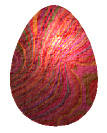
In Greece, the egg honors the blood of Christ by exchanging Crimson eggs.
They eat a dish known as Paska which is also eaten with a traditional bread known as Kulich a sweet saffron bread.
In Sydney, Australia there is an agricultural show known as "the Royal Easter Show". Which has displays of the countries best produce, farm animals, parades, rides, fireworks, food, sideshows and fun.
They enjoy the Easter holidays, which is the end of summer. Especially the children, love Easter eggs, chocolate rabbits, chocolate bilbies and time together with the family.
In Australia the Australians prefer the "Bilby"
as the symbol for Easter as it is native to Australia and also because of the
fact that the rabbit has destroyed land, crops, vegetation and burrows of
other native Australian species.
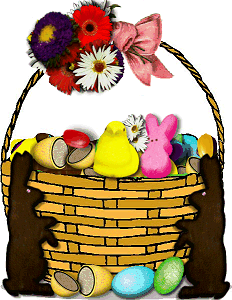 Saturday before Easter. Inside the basket they place
beautifully colored eggs, bread, cake, salt, paper and white colored
sausages and with the basket they then go to church to have the basket of
food blessed. It is believed that Great Lent which is the
forty day fast before Easter is not over until the basket has been blessed
hence the reason why it is called Blessing Basket.
Saturday before Easter. Inside the basket they place
beautifully colored eggs, bread, cake, salt, paper and white colored
sausages and with the basket they then go to church to have the basket of
food blessed. It is believed that Great Lent which is the
forty day fast before Easter is not over until the basket has been blessed
hence the reason why it is called Blessing Basket.
All that is contained in the basket is of meaning such as the colored eggs mean the risen Christ, the bread and salt are for good health and a prosperous life, the sausages are supposed to be a wish for enough food and fertility for the coming spring. There is also cheese and marzipan which are another part of the Easter basket.
Another tradition is the tradition of Watering which is where everyone splashes each other with water as this is considered to bring good health to all. No one is safe from this tradition.
In Poland girls used to send eggs to their favorite
boyfriends. Finnish children would beat the grown-ups with birch twigs until
they were given eggs for ransom.
Or another variation as the eggs are cracked after the midnight service and during the next days. One egg is cracked on the wall of the church. The ritual of cracking the eggs takes place before the Easter lunch. Each person selects his/her egg. Then people take turns tapping their egg against the eggs of others, and the person who ends up with the last unbroken egg is believed to have a year of good luck.
Another tradition is the oldest woman of the family wipes the faces of all the children in the house with the first red egg colored, which is supposed to bring them happiness and keep them healthy and strong.
The most predominate tradition is the making of the Easter bread. The bread is made by all women not bought and has a taste that is tasty, sweet, aromatic and rich and shows the temperament of the Bulgarians.
The traditional greeting is "Christ is Risen!"
to which is said "Indeed He is Risen!" This is the greeting
during 40 days after Pascha. Also, These greetings are exchanged during the
tapping of the eggs they are repeated 3 times and the actual tapping is after
that.
Most Norwegians to go up to the mountains and the snow. It is believed that the reason why do this is that the first Norwegian was the tribe's fool. At the end of the last glacial epoch, he left the tribe and stumbled after the retreating ice ending up in Norway. The conclusion is very simple that he is still doing the same thing! When one, unbelievably, has survived yet another cold, dark and freeze wintertime and the magic of spring at last occurs then the Norwegians still go up to the mountains hunting for snow and ice.
In Norway everyone plays the game known as the egg-knocking
game.
The most important Christian holiday is the day of Jesus' Resurrection. Cleaning the houses, wearing new clothes, the ritual bath before going to church, all these are supposed to mark a new beginning. After a long fast - the Lent, tables full with all sorts of good dishes and brightened up with beautiful painted eggs create a festive atmosphere. Children are the happiest of all looking for their gifts and colored eggs in the newly grown grass.
Everybody including the peasants are beautifully dressed in their national costumes, with lit candles in their hands, gathered together around the churches at midnight in order to solemnly utter: "Jesus Christ has risen from the dead". Everywhere around the churches, on the hills or in the plains, people light fires and sing Our Saviour's praises.
After the service, their is a multitude of flaring lit candles, a most uplifting
and touching sight, make for home where people clink Easter eggs with
beautifully dyed or exquisitely painted shells. The craftsmanship of dyeing the
eggs at Easter, is an ancient tradition with Romanians, is due to the belief
that eggs represent the source of life. The egg, preserver of the mystery of the
origin of life, has always been related to the rites of the revival of nature.
There is definitely a close link between Easter, the egg and the vernal equinox
as the three of them cheese, cake, lamb roast and broth, drob which is a spiced
minced lamb and fresh cottage cheese.
There are certain superstitions attached to Easter. People believed that witches were especially active and their black magic especially powerful during this week. On Maundy Thursday they were thought to fly off on brooms to consort with the devil at some place called "blåkulla", returning the following Saturday.
Another superstition On Maunday Thursday or Easter Eve Swedish girls and boys dress up as hags and pay visits to their neighbors. Some leave a small decorated card, an "Easter letter", hoping for a sweet or coin in return. The custom of making "Easter letters" is especially widespread in western Sweden. This is where it is also the custom to slip the letter into a persons mailbox or under his door without being seen. The identity of the sender is a secret.
Easter bonfires are also especially the custom in the western provinces, where villages vie to see who can make the biggest one. The custom of shooting also lives on, albeit in the form of shooting off fireworks.
Eggs are the most common Easter food, and hard boiled eggs are traditionally eaten the evening before Easter Sunday. While the eggs are often decorated, neither their decorations nor the traditions associated with them are as elaborate as in many countries on the continent.
On Good Friday in Northern Sweden there was a custom which wasn't that pleasant for the girls... Early in the morning the boys in the village gathered, equipped with birch twigs. Then they went to every farm in the neighborhood and whipped the girls with the branches until they gave the boys something to drink, and that wasn't water... After some visits to the farm the boys usually lost a bit of their judgment and sometimes it could be rather unpleasant for the girls... On the other hand, the girls got their revenge on the night between Easter day and Easter Monday when they in turn gathered to give the boys some of their own medicine.
On the Wednesday before Easter known as Dymmelsonsdagen it was common practice to fasten some kind of object for obvious reason, something which would make the bearer silly on the back of some poor unsuspecting victim. The whole point was that the victim shouldn't notice the object and walk around with it the whole day.
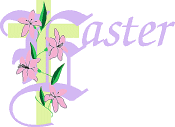
Palm Sunday
Palm Sunday is the Sunday before Easter Day. It is to commemorate Jesus's last
journey to Jerusalem, when people cut palm branches to spread on his path as he
rode to the city. Many other traditions are associated with Palm Sunday. In some
parts of England it used to be called Fig Sunday because people ate fig pies or
puddings on that day. In Wales it is called Sul y Blodau, Flowering Sunday.
In Greece people like to eat fish on Palm Sunday. In some German towns people decorate poles with streamers and branches of pussy willow. Christians in Lebanon like to wear new clothes on Palm Sunday. In Italy it is regarded as a day or making up quarrels.
Holy Thursday
Holy Thursday also referred to as Maundy Thursday. In Europe the Christian
monarchs used to wash the feet of poor people on the Thursday before Easter in
memory of Jesus's Act.
Also on this day Jesus ate and drank with his followers. This meal became known as the Last Supper, because Jesus died soon after.
Good Friday
Good Friday is the commemoration of the Trial and Crucifixion of Jesus. In some
countries the bells are tolled while in other countries they are silenced until
Sunday. A custom also is the eating of Hot Cross Buns. Many superstitions go
with hot cross buns such as they are a charm against evil and to keep
indefinitely.
An Old Rhyme says:
Good Friday comes this month: the old woman runs
With one a penny, two a penny hot cross buns;
Whose virtue is, if you'll believe what's said,
They'll not grow mouldy like the common bread.
Holy Saturday
Holy Saturday is part of the period mourning which begins on Good Friday. For
Christians in countries such as Bulgaria, Greece and Poland, Hoy Saturday is a
day of cooking, ready for the feasting the following day to celebrate the
Resurrection.
Easter Day
Easter day is the Commemoration of the Resurrection of Jesus, with its promise
of eternal life. A symbol of the Resurrection is the egg out of which a bird
hatches.
Easter Monday
Easter Monday is day of sports and games of various kinds. In Britain Football
is the game played. Also the game of egg shackling in which you hold a
hard-boiled egg firmly in your hand and hit against another opponents. Another
is Ducking Monday.
Ascension
Ascension is the fortieth day from Easter Day. It was on this day that Jesus
ascended into Heaven. Ascension Day falls on a Thursday. The Paschal candle
which was lit on Easter Day to mark the resurrection is put out to mark Jesus's
departure from Earth.
The Lenten Season
Lent is the forty-six day period
just prior to Easter Sunday. It begins on Ash Wednesday. Mardi Gras (French for
"Fat Tuesday") is a celebration, sometimes called
"Carnival," practiced around the world, on the Tuesday prior to Ash
Wednesday. It was designed as a way to "get it all out" before the
sacrifices of Lent began. New Orleans is the focal point of Mardi Gras
celebrations in the U.S. Read about the religious meanings of the Lenten Season.
Shrove Tuesday, Ash Wednesday and Lent
If you live outside the UK, you probably haven't heard of Shrove Tuesday.
But you probably know it by its other name, Mardi Gras. Pancakes were originally
eaten on Shrove Tuesday -- the Tuesday before Lent -- to use up eggs and fat
before the fast of Lent. Today, these pancakes are generally made of eggs, milk
and flour. The word "shrove" comes from "shrive," meaning
"the confessions of sins" -- something done in preparation for Lent.
Ash Wednesday is a day of fasting that gets its name from the practice of sprinkling ashes over those engaging in the fast of Lent. Has anyone ever apologized to you by saying, "Let me put on my ashes and sackcloth..."? This is where that saying originated. Those wishing to receive the sacrament of penance were known as "penitents." They wore sackcloth and were required to remain apart from the Christian community until Maundy Thursday. This practice fell into disuse during the eighth, ninth and 10th centuries, when the beginning of Lent was symbolized by placing ashes on the heads of the entire congregation.
Today, Christians have a cross put on their forehead in ashes. The ashes are usually made from the previous year's blessed palm fronds from Palm Sunday, and are usually wet with holy water before being used.
The name Lent comes from the Middle English "lenten," meaning "spring." Lent signifies 40 days of fasting in order to imitate the fast of Jesus Christ after his baptism (the Epiphany). Lent begins on Ash Wednesday, 46 days before Easter Sunday, when it ends.
Other Easter Days
Eastertide goes on until Whit Sunday, fifty days after Easter day. The day is
also known as Pentecost. Several other days during Eastertide are; the first
Sunday after Easter is known as Low Sunday. In England the Monday and Tuesday
following Low Sunday are called Hocktide. Hocktide Monday is were the women bind
and gag them until they pay a ransom, then on Tuesday it's the men's turn to do
the same in kind to the women. This tradition is at least a thousand years old.
The Date of Easter
Unlike festivals such as Christmas, Easter has been celebrated without interruption since New Testament times. The dates of all movable feasts are also calculated around the date of Easter. According to the Encyclopedia Britannica,
"...western Christians celebrate Easter on the first Sunday after the full moon (the paschal moon) that occurs on or next after the vernal equinox on March 21. If the paschal moon, which is calculated from a system of golden numbers and epacts and does not necessarily coincide with the astronomical full moon, occurs on a Sunday, Easter is the following Sunday."
The U.S. Naval Observatory's Astronomical Applications Department says that Easter is determined by the "ecclesiastical moon" as defined by church-constructed tables to be used permanently for calculating the phase of the moon. This full moon doesn't necessarily coincide with the astronomical full moon, which means, Navy researchers say, that Easter is not necessarily the very next Sunday after a full moon. It could be the next Sunday after the ecclesiastical moon. This happened in 1876.
These calculations say that Easter can fall between March 22 and April 25. This was decreed by Pope Gregory XIII in 1582 as part of the Gregorian calendar.
During New Testament times, the Christian church celebrated Easter at the same time as the Jews observed Passover (the first of Passover's eight days is Nissan 15 on the Jewish calendar. Passover observes the flight and freedom of the Israelites from slavery in Egypt). By the middle of the second century, Easter was celebrated on the Sunday after Passover. The Council of Nicaea decided in 325 A.D. that all churches should celebrate it together on a Sunday.
The Eastern Orthodox church may celebrate Easter up to a month later, as its calculation of the date is based on the Julian calendar, which is currently 13 days behind the Gregorian calendar. In 1865 and 1963, Easter observance in both eastern and western churches coincided.
In some countries, Good Friday and the Monday after Easter are national holidays. In the United States, these two days are not federal holidays and observance varies from state to state.
Copyright ©Emotions Greeting Cards a division of VH Productions 2000-2003